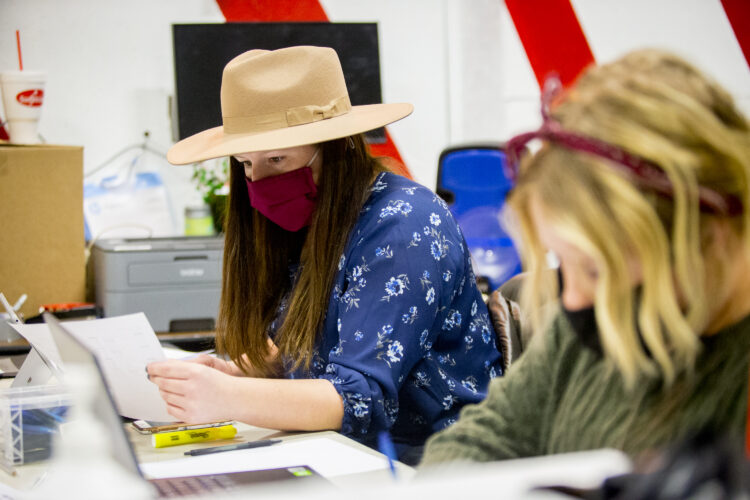Study shines light on effects of COVID-19 on working women’s health

Isaac Hale Daily Herald
Kayla Bradshaw, director of United Way’s Volunteer Center, looks over information with volunteer Deserie Peck as part of the United Way of Utah County's Sub for Santa program Tuesday, Dec. 22, 2020, at Community Action Services and Food Bank in Provo. (Isaac Hale, Daily Herald file photo)The effects of the COVID-19 pandemic have reached the depths of personal life throughout the world. A new research project examined how those have trickled down to women in Utah.
On Wednesday, the Utah Women & Leadership Project released its last in a series of six studies on “The Impact of COVID-19 on Utah Women and Work” with the final study looking at the health impacts.
According to Susan Madsen, the project director, the following are part of the survey’s cause and effect responses:
- A mental health toll was the most often-mentioned effect of the pandemic — Respondents mentioned increased stress, depression, anxiety, guilt, burnout, loneliness and general mental health decline.
- Causes of mental health tolls were analyzed — The most common causes included increased pressure at work, the fear of contracting and spreading COVID-19 (largely from those who couldn’t work from home), having children at home who required extra attention, increased financial instability and specific experiences of those working the front lines such as health care workers and educators.
- Physical health was impacted in direct and indirect ways — Respondents describe suffering from COVID-19 themselves, and the indirect impacts it had on their professional and personal lives. Other indirect physical effects mentioned stem from the increased stress of the pandemic, like stomach ulcers and digestive issues.
- Flexibility and remote work improved mental and physical health — For some respondents, time saved from a daily commute meant a better work/life balance where respondents had more time for their family, hobbies and exercise.
“We collected data in January,” Madsen said, with 3,500 women responding.
What surprised Madsen, she said, was the number of respondents who gave deeper, longer written comments rather than just checking a box or circling a number.
Two thousand, seven hundred people “gave us deeper comments,” Madsen said. “That took us a long time to code everything.”
Madsen noted some of the comments were poignant stories of personal experiences with physical and mental health.
According to the data, 9% of women surveyed actually said they improved in both physical and mental health.
“Seventy childcare providers took the survey and said it has taken a big toll on them,” Madsen said. “School teachers also expressed the same.”
“While the fatality rate has been higher for men, the pandemic impacted women’s mental health at a higher rate with more women being laid off or furloughed in certain industries (e.g., retail, food services, hospitality), experiencing increased workloads in other sectors (e.g., health care, education), absorbing greater unpaid caregiving responsibilities from homeschooling and childcare disruptions, and reporting elevated instances of domestic violence,” said Marin Christensen, the assistant director who prepared the research and policy brief.
“These impacts have led to increased post-traumatic stress disorder, anxiety, and depression among women,” she added.
Christensen noted there were no clear trends that emerged in the analysis of qualitative responses that mentioned a mental health toll by demographics such as age, education level, race or ethnicity, marital status, industry or career stage.
The qualitative data indicate declined mental health despite demographic and workforce differences, according to Christensen.
Causes of the mental health toll include work pressure, contracting and spreading COVID-19, children at home, financial instability and essential workers.
One health care worker stated, “I’ve got quite a few patients with risk factors. It’s stressful thinking that if I unknowingly passed COVID along to them, someone could potentially die from it. So, my personal life has changed dramatically. I basically only interact in person with my husband and daughter. Sometimes, I feel quite isolated. Throughout the course of my workday, although I’m taking precautions, I feel vulnerable to becoming infected. It’s stressful. Every patient comes in with an increased level of stress and anxiety due to the pandemic, so I’m interacting with stressed, anxious people all day.”
A teacher also explained, “My administration seems to think the precautions are ‘over the top’ when they are actually barely meeting the minimum. We’re scared, overwhelmed, and feeling totally burned out. We have to keep track of virtual, in-person, and quarantined students. It feels like we’re doing multiple jobs at once. This is my 8th year of teaching and the first year that I hate my job.”
Christensen said the most used word, found in over 16,000 comments, was the word “pressure.”
The effects of the mental health toll include, among other things; stress, anxiety, burnout and fatigue, isolation and loneliness.

Health care worker Amy Dalton holds a test tube as fellow health care worker Shelby Smith puts the tip of a used swap into the test tube to eventually be tested at a COVID-19 testing site outside of Timpanogos Regional Hospital in Orem on Monday, Aug. 17, 2020.
“Of the 2,530 respondents who responded to the open-ended question, ‘What benefits, if any, have you experienced (or anticipate experiencing) in your job/career because of the COVID-19 pandemic?’ 43.5% mentioned the ability to work from home and/or more flexibility in their schedules,” Christensen said.
“A large proportion of those respondents said the increased flexibility and remote work improved their physical and/or mental health,” she added.
Of the 9% of respondents who mentioned mental and physical benefits of the pandemic, 56.9% attributed the benefits to working from home and flexibility. Respondents felt they were better able to focus and could be more productive working from home.
They appreciated the time saved from having no commute, which helped them better fit in time for valued activities, relationships and exercise.
One respondent stated, “I work 100% from home now. I love it! My mental and physical health is better. Less stress, better eating habits, calmer. I’m saving money by not driving and buying clothes for work. My overall quality of life has improved dramatically. I have more quality time with loved ones. I can’t say enough about the positive impact on my life personally.”
Summarizing the feelings of many respondents, one woman said, “The freedom of working from home has been huge. I didn’t realize how much stress was involved in physically being at the office. I feel I’ve been better able to care for myself and my household by physically being in my home more often.”
Christensen said she would like to continue with more surveys to particularly respond to the paradigm change in woman’s jobs and careers.
In her conclusion, Christensen said, “The pandemic has impacted nearly every aspect of Utah women’s lives, which, for most, includes their physical and mental health. Ensuring that women can thrive mentally and physically is important moving forward.”
“As Utah leaders and residents better understand the challenges that Utah women have faced related to COVID-19, a more equitable recovery can be crafted. This will, in turn, strengthen our businesses, families, communities, and the state as a whole,” Christensen added.
For those who would like to read the entire brief you can visit https://www.usu.edu/uwlp/files/briefs/37-covid-19-health-impacts.pdf.



